Aggregation, Cytotoxicity and DNA Binding in a Series of Calix[4]arene Amphiphile Containing Aminotriazole Groups
Abstract
1. Introduction
2. Results and Discussion
2.1. Synthesis
2.2. Study of the Self-Assembly of Calixarenes
2.2.1. Determination of the Critical Aggregate Concentration (CAC)
2.2.2. Determination of the Size and Zeta Potential of Calixarenes
2.3. Interaction of Calixarenes with DNA
2.3.1. Absorption Spectroscopy Measurements
2.3.2. DNA Melting Temperature (Tm) Study
2.3.3. Fluorescence Spectroscopic Studies—Competitive Displacement Assay
2.3.4. Particle Size and Zeta Potential Measurements
2.3.5. Transmission Electron Microscopy (TEM)
2.4. Cytotoxicity Analysis of Calixarenes
3. Materials and Methods
3.1. Characterization Methods
3.2. Materials
Synthesis
3.3. Sample Preparation
3.4. UV Absorption Spectroscopic Study
3.5. Steady-State Fluorescence Study
3.6. Dynamic and Electrophoretic Light Scattering Study
3.7. Transition Electron Microscopy (TEM) Study
3.8. Cell Culture Cultivating
3.9. Addition of the Studied Compounds to Cells
3.10. Cytotoxicity Analysis of the Compounds
4. Conclusions
Supplementary Materials
Author Contributions
Funding
Institutional Review Board Statement
Informed Consent Statement
Data Availability Statement
Conflicts of Interest
References
- Neri, P.S.; Sessler, J.L.; Wang, M.-X. Calixarenes and Beyond; Springer: New York, NY, USA, 2016. [Google Scholar] [CrossRef]
- Bilal, M.; Fernandes, C.D.; Mehmood, T.; Nadeem, F.; Tabassam, Q.; Ferreira, L.F.R. Immobilized lipases-based nano-biocatalytic systems—A versatile platform with incredible biotechnological potential. Int. J. Biol. Macromol. 2021, 175, 108–122. [Google Scholar] [CrossRef]
- Basilotta, R.; Mannino, D.; Filippone, A.; Casili, G.; Prestifilippo, A.; Colarossi, L.; Raciti, G.; Esposito, E.; Campolo, M. Role of Calixarene in Chemotherapy Delivery Strategies. Molecules 2021, 26, 3963. [Google Scholar] [CrossRef]
- An, L.; Wang, C.; Zheng, Y.-G.; Liu, J.-d.; Huang, T.-h. Design, synthesis and evaluation of calix[4]arene-based carbonyl amide derivatives with antitumor activities. Eur. J. Med. Chem. 2021, 210, 112984. [Google Scholar] [CrossRef]
- Shurpik, D.N.; Padnya, P.L.; Stoikov, I.I.; Cragg, P.J. Antimicrobial Activity of Calixarenes and Related Macrocycles. Molecules 2020, 25, 5145. [Google Scholar] [CrossRef]
- Fang, S.; Dang, Y.-Y.; Li, H.; Li, H.; Liu, J.; Zhong, R.; Chen, Y.; Liu, S.; Lin, S. Membrane-Active Antibacterial Agents Based on Calix[4]arene Derivatives: Synthesis and Biological Evaluation. Front. Chem. 2022, 10, 816741. [Google Scholar] [CrossRef]
- Ali, Y.; Muhamad Bunnori, N.; Susanti, D.; Muhammad Alhassan, A.; Abd Hamid, S. Synthesis, in-Vitro and in Silico Studies of Azo-Based Calix[4]arenes as Antibacterial Agent and Neuraminidase Inhibitor: A New Look Into an Old Scaffold. Front. Chem. 2018, 6, 210. [Google Scholar] [CrossRef] [PubMed]
- Muneer, S.; Memon, S.; Pahnwar, Q.K.; Bhatti, A.A.; Khokhar, T.S. Synthesis and investigation of antimicrobial properties of pyrrolidine appended calix[4]arene. J. Anal. Sci. Technol. 2017, 8, 3. [Google Scholar] [CrossRef]
- Dono Gezelbash, Z.; Akbari Dilmaghani, K. Synthesis, antifungal and antibacterial activity of calix[4]arene-based 1,3,4-oxadiazole derivatives. J. Chin. Chem. Soc. 2020, 67, 1446–1452. [Google Scholar] [CrossRef]
- Geraci, C.; Consoli, G.M.L.; Galante, E.; Bousquet, E.; Pappalardo, M.; Spadaro, A. Calix[4]arene Decorated with Four Tn Antigen Glycomimetic Units and P3CS Immunoadjuvant: Synthesis, Characterization, and Anticancer Immunological Evaluation. Bioconjug. Chem. 2008, 19, 751–758. [Google Scholar] [CrossRef]
- Da Silva, D.L.; Silva Terra, B.; Ribeiro Lage, M.; Lúcia Tasca Góis Ruiz, A.; Capeletti da Silva, C.; Ernesto de Carvalho, J.; Walkimar de Mesquita Carneiro, J.; Terra Martins, F.; Antonio Fernades, S.; de Fátima, Â. Xanthenones: Calixarenes-catalyzed syntheses, anticancer activity and QSAR studies. Org. Biomol. Chem. 2015, 13, 3280–3287. [Google Scholar] [CrossRef]
- Oguz, M.; Yildirim, A.; Durmus, I.M.; Karakurt, S.; Yilmaz, M. Synthesis of new calix[4]arene derivatives and evaluation of their cytotoxic activity. Med. Chem. Res. 2022, 31, 52–59. [Google Scholar] [CrossRef]
- Läppchen, T.; Dings, R.P.M.; Rossin, R.; Simon, J.F.; Visser, T.J.; Bakker, M.; Walhe, P.; van Mourik, T.; Donato, K.; van Beijnum, J.R.; et al. Novel analogs of antitumor agent calixarene 0118: Synthesis, cytotoxicity, click labeling with 2-[18F]fluoroethylazide, and in vivo evaluation. Eur. J. Med. Chem. 2015, 89, 279–295. [Google Scholar] [CrossRef] [PubMed]
- Sansone, F.; Dudič, M.; Donofrio, G.; Rivetti, C.; Baldini, L.; Casnati, A.; Cellai, S.; Ungaro, R. DNA Condensation and Cell Transfection Properties of Guanidinium Calixarenes: Dependence on Macrocycle Lipophilicity, Size, and Conformation. J. Am. Chem. Soc. 2006, 128, 14528–14536. [Google Scholar] [CrossRef]
- Ibragimova, R.R.; Burilov, V.A.; Aimetdinov, A.; Mironova, D.; Evtugyn, V.; Osin, Y.; Solovieva, S.; Antipin, I. Polycationic Derivatives of p-tert-Butylthiacalix[4]arene in 1,3-alternate Stereoisomeric Form: New DNA Condensing Agents. Macroheterocycles 2016, 9, 433–441. [Google Scholar] [CrossRef]
- Español, E.S.; Villamil, M.M. Calixarenes: Generalities and Their Role in Improving the Solubility, Biocompatibility, Stability, Bioavailability, Detection, and Transport of Biomolecules. Biomolecules 2019, 9, 90. [Google Scholar] [CrossRef] [PubMed]
- Ostos, F.J.; Lebrón, J.A.; López-Cornejo, P.; López-López, M.; García-Calderón, M.; García-Calderón, C.B.; Rosado, I.V.; Kalchenko, V.I.; Rodik, R.V.; Moyá, M.L. Self-aggregation in aqueous solution of amphiphilic cationic calix[4]arenes. Potential use as vectors and nanocarriers. J. Mol. Liq. 2020, 304, 112724. [Google Scholar] [CrossRef]
- Migliore, R.; Granata, G.; Rivoli, A.; Consoli, G.M.L.; Sgarlata, C. Binding Affinity and Driving Forces for the Interaction of Calixarene-Based Micellar Aggregates with Model Antibiotics in Neutral Aqueous Solution. Front. Chem. 2021, 8, 626467. [Google Scholar] [CrossRef]
- Nakai, T.; Kanamori, T.; Sando, S.; Aoyama, Y. Remarkably Size-Regulated Cell Invasion by Artificial Viruses. Saccharide-Dependent Self-Aggregation of Glycoviruses and Its Consequences in Glycoviral Gene Delivery. J. Am. Chem. Soc. 2003, 125, 8465–8475. [Google Scholar] [CrossRef]
- Shahgaldian, P.; Sciotti, M.A.; Pieles, U. Amino-Substituted Amphiphilic Calixarenes: Self-Assembly and Interactions with DNA. Langmuir 2008, 24, 8522–8526. [Google Scholar] [CrossRef]
- Nault, L.; Cumbo, A.; Pretôt, R.F.; Sciotti, M.A.; Shahgaldian, P. Cell transfection using layer-by-layer (LbL) coated calixarene-based solid lipid nanoparticles (SLNs). Chem. Commun. 2010, 46, 5581–5583. [Google Scholar] [CrossRef]
- Weeden, C.; Hartlieb, K.J.; Lim, L.Y. Preparation and physicochemical characterization of a novel paclitaxel-loaded amphiphilic aminocalixarene nanoparticle platform for anticancer chemotherapy. J. Pharm. Pharmacol. 2012, 64, 1403–1411. [Google Scholar] [CrossRef]
- Fatykhova, G.A.; Makarov, E.G.; Mironova, D.A.; Sultanova, E.D.; Burilov, V.A.; Solovieva, S.E.; Antipin, I.S. New Amphiphilic Calix[4]Arene Derivatives with 4,5-Dicarboxytriazolyl Fragments: Synthesis and Use in Micellar Catalysis. Russ. J. Phys. Chem. B 2019, 13, 401–407. [Google Scholar] [CrossRef]
- Burilov, V.; Makarov, E.; Mironova, D.; Sultanova, E.; Bilyukova, I.; Akyol, K.; Evtugyn, V.; Islamov, D.; Usachev, K.; Mukhametzyanov, T.; et al. Calix[4]arene Polyamine Triazoles: Synthesis, Aggregation and DNA Binding. Int. J. Mol. Sci. 2022, 23, 14889. [Google Scholar] [CrossRef] [PubMed]
- Gutsche, C.D.; Bauer, L.J. Calixarenes. 13. The conformational properties of calix[4]arenes, calix[6]arenes, calix[8]arenes, and oxacalixarenes. J. Am. Chem. Soc. 1985, 107, 6052–6059. [Google Scholar] [CrossRef]
- Aguiar, J.; Carpena, P.; Molina-Bolívar, J.A.; Carnero Ruiz, C. On the determination of the critical micelle concentration by the pyrene 1:3 ratio method. J. Colloid Interface Sci. 2003, 258, 116–122. [Google Scholar] [CrossRef]
- Mura, M.; Carucci, C.; Marincola, F.C.; Monduzzi, M.; Parsons, D.F.; Salis, A. The melting curves of calf thymus-DNA are buffer specific. J. Colloid Interface Sci. 2023, 630, 193–201. [Google Scholar] [CrossRef]
- Li, S.; Pan, J.; Zhang, G.; Xu, J.; Gong, D. Characterization of the groove binding between di-(2-ethylhexyl) phthalate and calf thymus DNA. Int. J. Biol. Macromol. 2017, 101, 736–746. [Google Scholar] [CrossRef]
- Lakowicz, J. Principles of Fluorescence Spectroscopy; Springer: New York, NY, USA, 2006. [Google Scholar] [CrossRef]
- Ross, P.D.; Subramanian, S. Thermodynamics of protein association reactions: Forces contributing to stability. Biochemistry 1981, 20, 3096–3102. [Google Scholar] [CrossRef]
- Fan, Y.; Wang, H.; He, C.; Qiao, F.; Wang, S.; Wang, Y. DNA Condensation Induced by a Star-Shaped Hexameric Cationic Surfactant. ACS Appl. Mater. Interfaces 2017, 9, 23333–23341. [Google Scholar] [CrossRef]
- Santos, D.; Medeiros-Silva, J.; Cegonho, S.; Alves, E.; Ramilo-Gomes, F.; Santos, A.O.; Silvestre, S.; Cruz, C. Cell proliferation effects of calix[4]arene derivatives. Tetrahedron 2015, 71, 7593–7599. [Google Scholar] [CrossRef]
- Méndez-Ardoy, A.; Gómez-García, M.; Mellet, C.O.; Sevillano, N.; Dolores Girón, M.; Salto, R.; Santoyo-González, F.; García Fernández, J.M. Preorganized macromolecular gene delivery systems: Amphiphilic β-cyclodextrin “click clusters”. Org. Biomol. Chem. 2009, 7, 2681–2684. [Google Scholar] [CrossRef] [PubMed]
- Gutsche, C.D.; Iqbal, M. p-tert-Butylcalix[4]arene. Org. Synth. 1990, 68, 234. [Google Scholar] [CrossRef]
- Zhang, T.-X.; Zhang, Z.-Z.; Yue, Y.-X.; Hu, X.-Y.; Huang, F.; Shi, L.; Liu, Y.; Guo, D.S. A General Hypoxia-Responsive Molecular Container for Tumor-Targeted Therapy. Adv. Mater. 2020, 32, 1908435. [Google Scholar] [CrossRef]
- Inman, R.B.; Jordan, D.O. The u.v.-absorption of calf-thymus DNA. Biochim. Biophys. Acta 1960, 42, 530–532. [Google Scholar] [CrossRef] [PubMed]


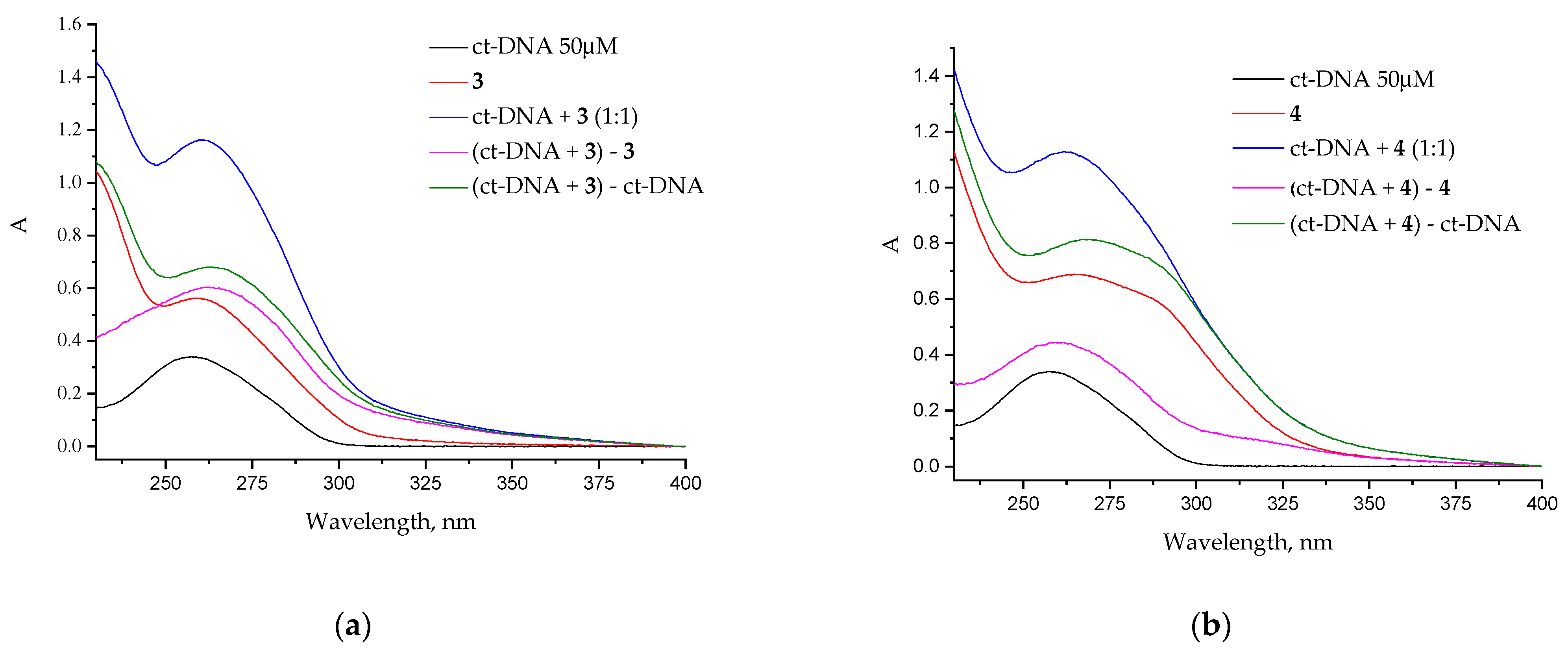

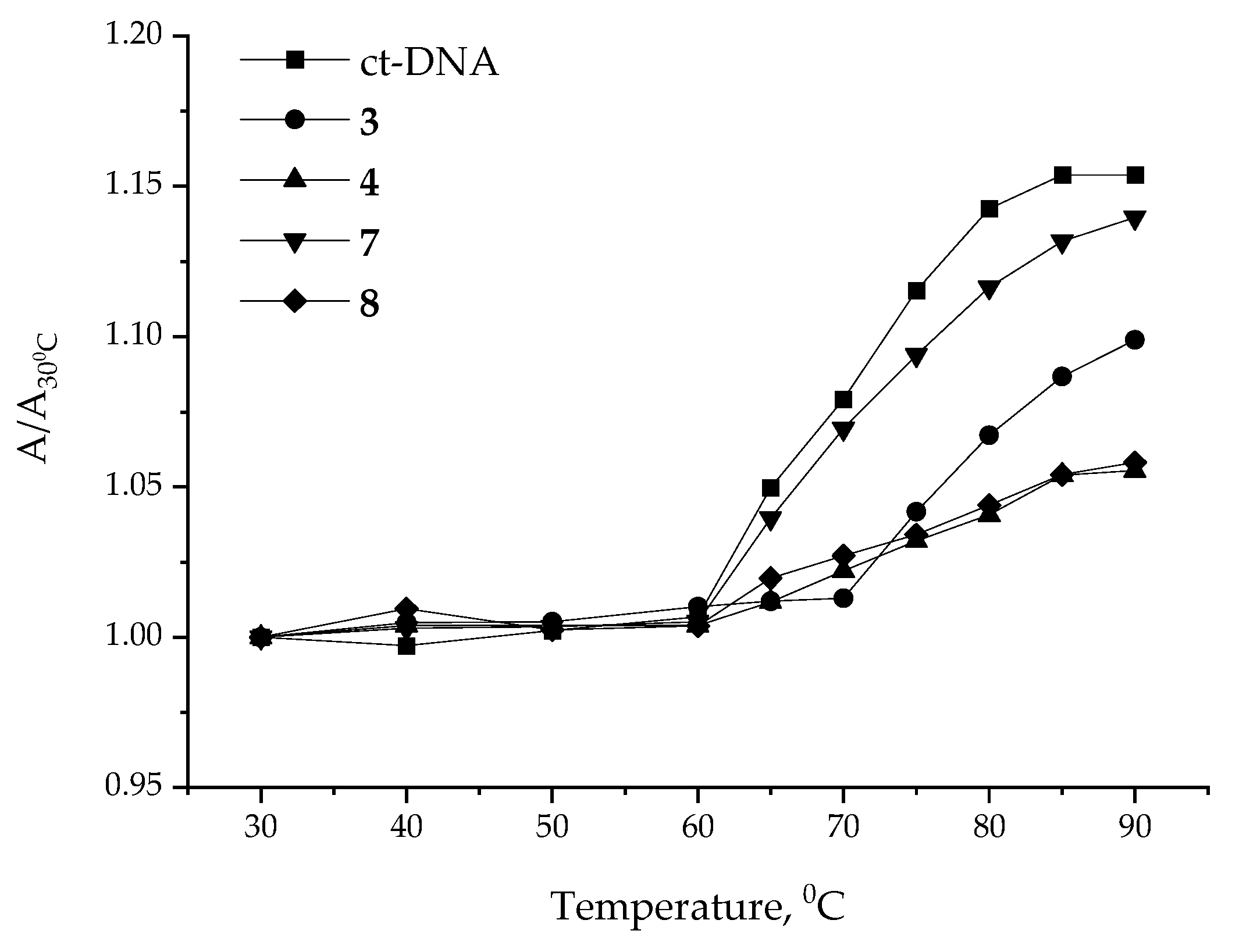
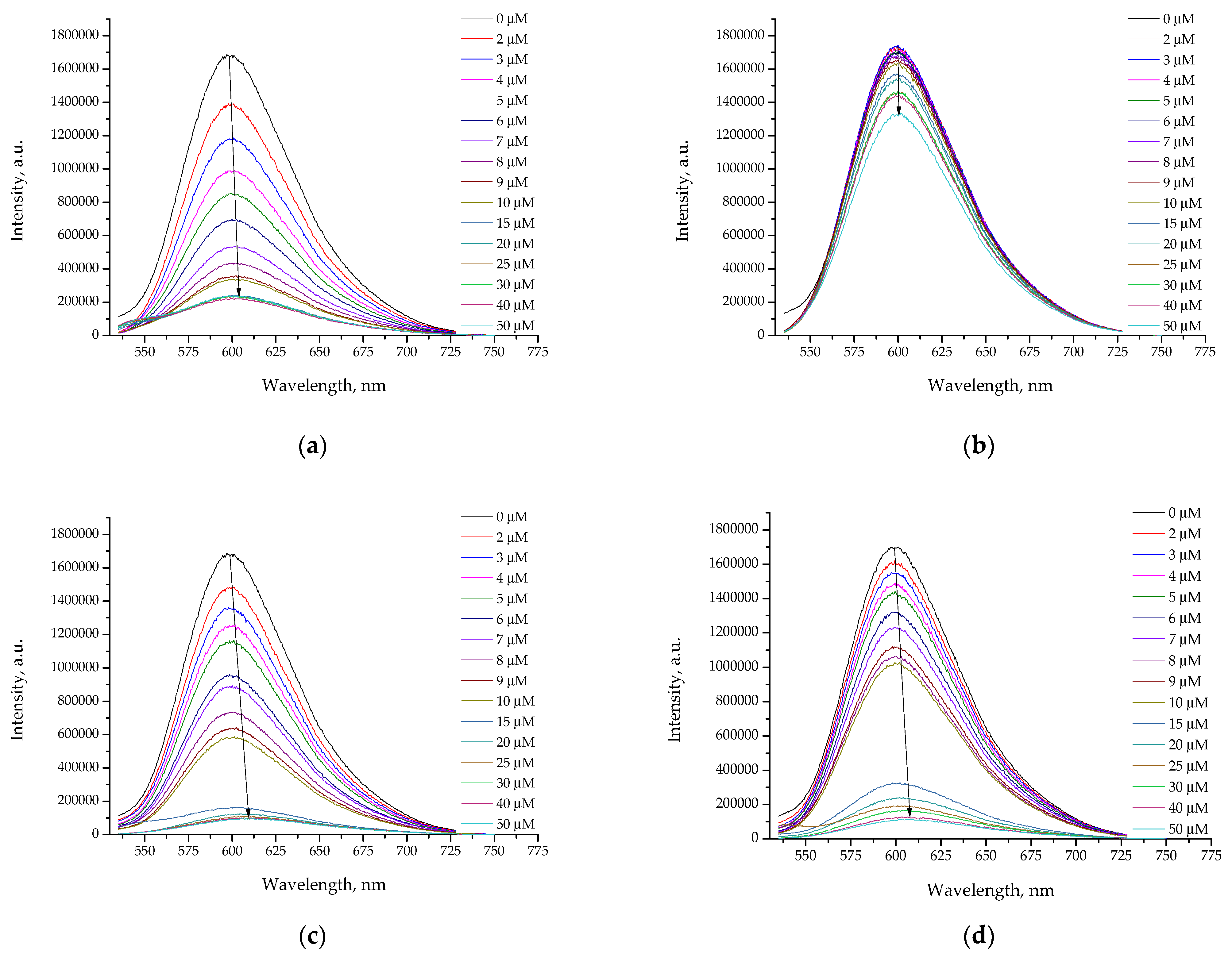
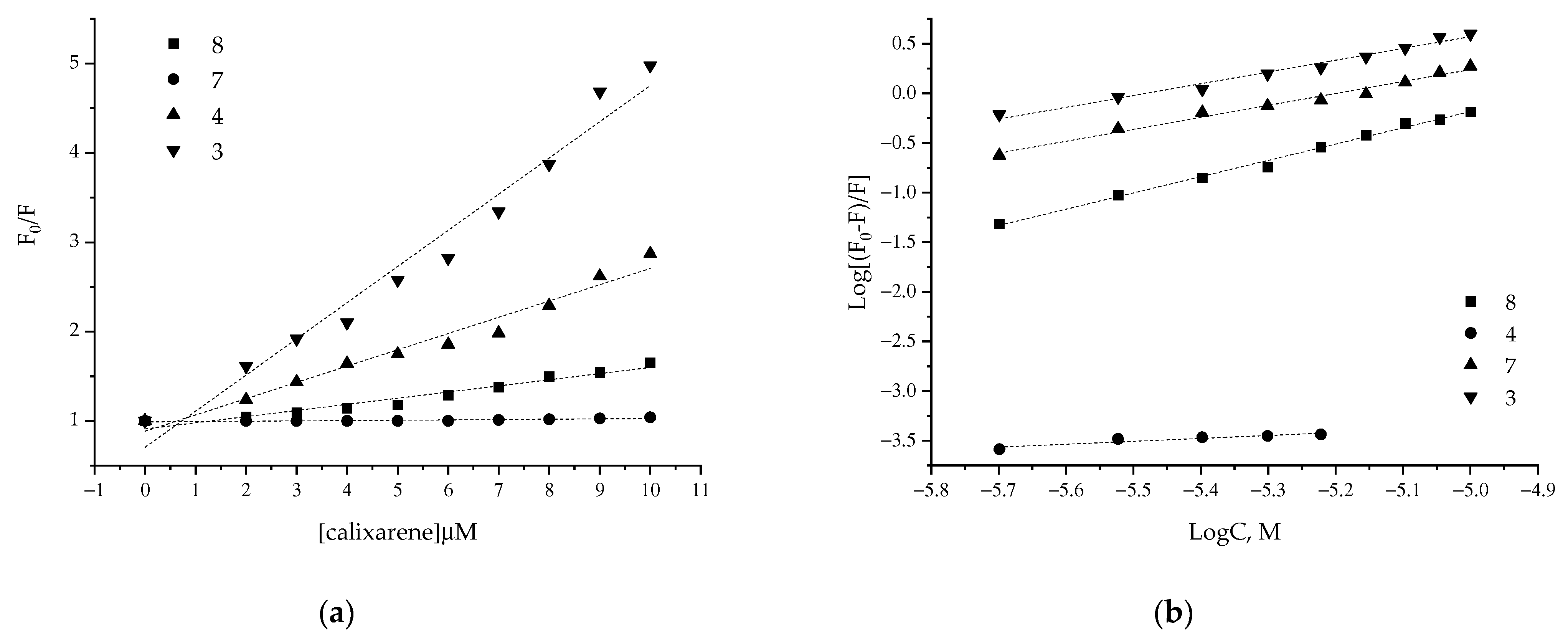

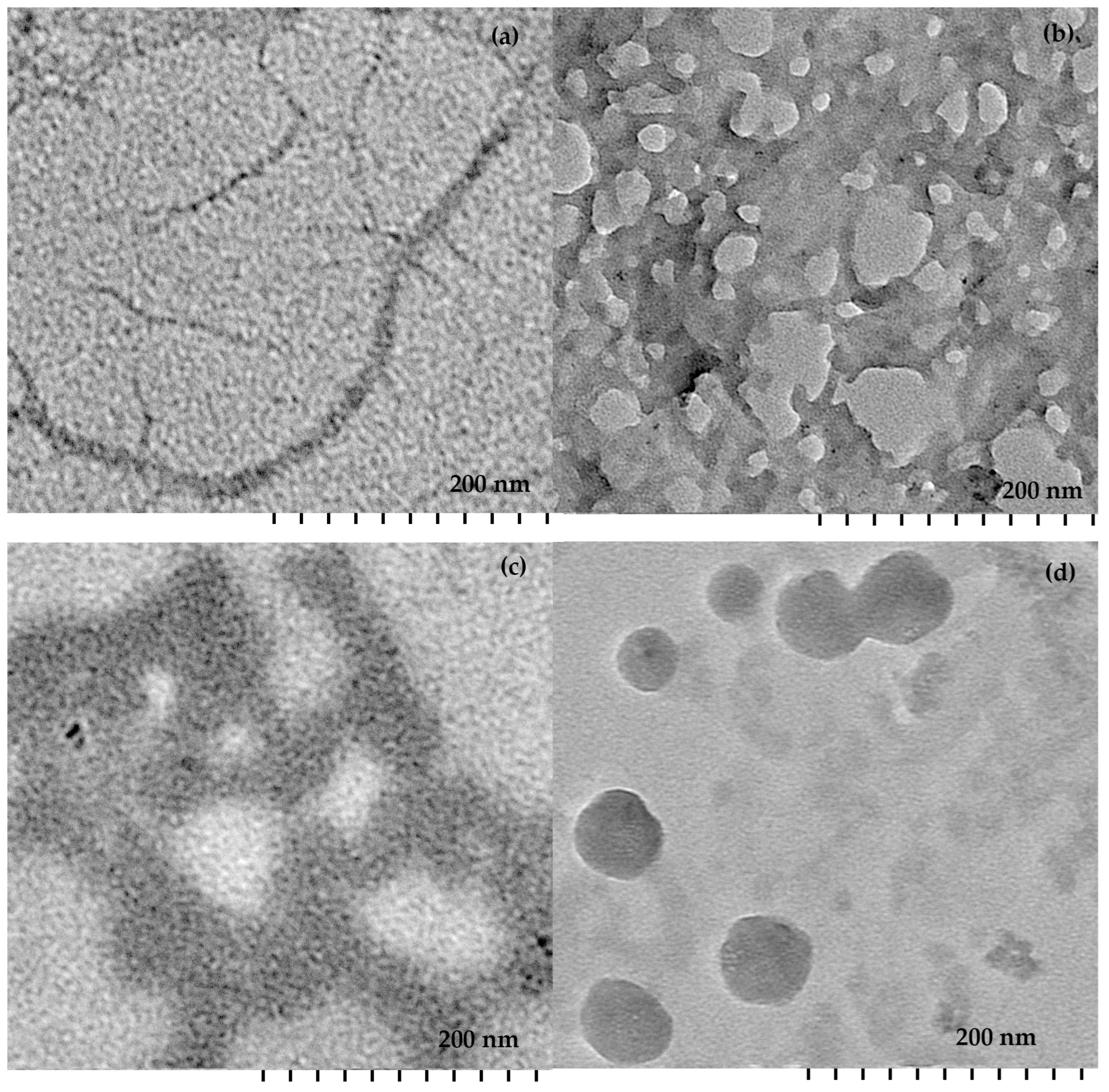
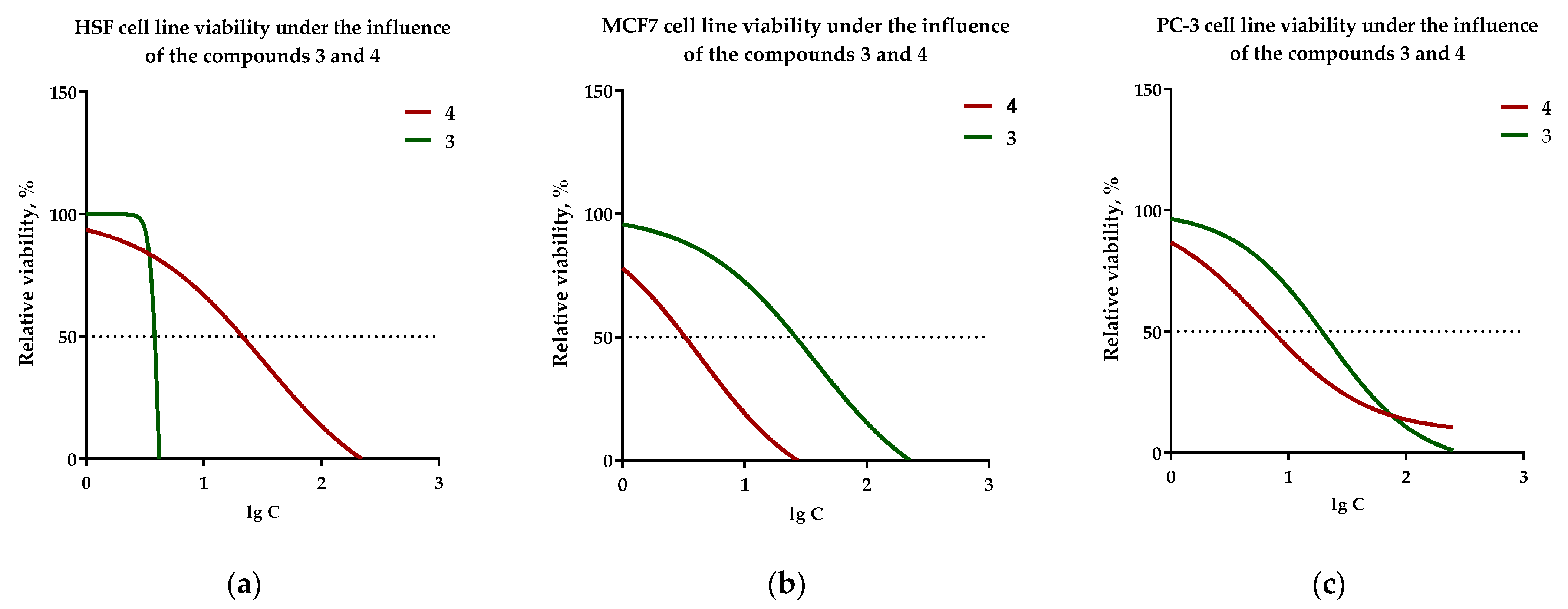
| Calixarene | CAC 1, μM | D Average, nm | d1, nm/(%) | d2, nm/(%) | PDI | ζ, mV |
|---|---|---|---|---|---|---|
| 3 | 6.9 | 19 ± 1 | 14 ± 1 (66%) | 203 ± 25 (34%) | 0.536 ± 0.023 | +50 ± 4 |
| 4 | - | 264 ± 35 | - | - | 0.391 ± 0.132 | +51 ± 11 |
| 7 | 4.9 | 150 ± 2 | - | - | 0.237 ± 0.012 | +47 ± 3 |
| 8 | - | 179 ± 12 | - | - | 0.216 ± 0.064 | +40 ± 5 |
| ** | S.D. | n | S.D. | |||||
|---|---|---|---|---|---|---|---|---|
| * ct-DNA + 3 | 0.9889 | 0.016 | 1.2 | 0.9899 | 0.32 | |||
| ct-DNA + 4 | 0.9889 | 0.072 | 1.2 | 0.9898 | 0.31 | |||
| ct-DNA + 7 | 0.9699 | 0.005 | - | - | - | - | ||
| ct-DNA + 8 | 0.9899 | 0.033 | 1.6 | 0.9989 | 0.25 |
| Temperature, K | ΔH (kJ mol−1) | ΔS (J mol−1 K−1) | ΔG (kJ mol−1) | |
|---|---|---|---|---|
| 3 | ||||
| 298.15 | −354 | 1314 | −746 | |
| 304.15 | −753 | |||
| 310.15 | −761 | |||
| 4 | ||||
| 298.15 | −128 | 550 | −292 | |
| 304.15 | −295 | |||
| 310.15 | −299 | |||
| 8 | ||||
| 298.15 | −191 | 761 | −418 | |
| 304.15 | −422 | |||
| 310.15 | −427 | |||
| 3 | 4 | 7 | 8 | |
|---|---|---|---|---|
| MCF7 | 3.8 | 3.3 | - | - |
| PC-3 | 19.3 | 7.4 | 108.7 | - |
| HSF | 3.8 | 21.3 | - | - |
Disclaimer/Publisher’s Note: The statements, opinions and data contained in all publications are solely those of the individual author(s) and contributor(s) and not of MDPI and/or the editor(s). MDPI and/or the editor(s) disclaim responsibility for any injury to people or property resulting from any ideas, methods, instructions or products referred to in the content. |
© 2023 by the authors. Licensee MDPI, Basel, Switzerland. This article is an open access article distributed under the terms and conditions of the Creative Commons Attribution (CC BY) license (https://creativecommons.org/licenses/by/4.0/).
Share and Cite
Mironova, D.; Makarov, E.; Bilyukova, I.; Akyol, K.; Sultanova, E.; Evtugyn, V.; Davletshin, D.; Gilyazova, E.; Bulatov, E.; Burilov, V.; et al. Aggregation, Cytotoxicity and DNA Binding in a Series of Calix[4]arene Amphiphile Containing Aminotriazole Groups. Pharmaceuticals 2023, 16, 699. https://doi.org/10.3390/ph16050699
Mironova D, Makarov E, Bilyukova I, Akyol K, Sultanova E, Evtugyn V, Davletshin D, Gilyazova E, Bulatov E, Burilov V, et al. Aggregation, Cytotoxicity and DNA Binding in a Series of Calix[4]arene Amphiphile Containing Aminotriazole Groups. Pharmaceuticals. 2023; 16(5):699. https://doi.org/10.3390/ph16050699
Chicago/Turabian StyleMironova, Diana, Egor Makarov, Islamiya Bilyukova, Kevser Akyol, Elsa Sultanova, Vladimir Evtugyn, Damir Davletshin, Elvina Gilyazova, Emil Bulatov, Vladimir Burilov, and et al. 2023. "Aggregation, Cytotoxicity and DNA Binding in a Series of Calix[4]arene Amphiphile Containing Aminotriazole Groups" Pharmaceuticals 16, no. 5: 699. https://doi.org/10.3390/ph16050699
APA StyleMironova, D., Makarov, E., Bilyukova, I., Akyol, K., Sultanova, E., Evtugyn, V., Davletshin, D., Gilyazova, E., Bulatov, E., Burilov, V., Solovieva, S., & Antipin, I. (2023). Aggregation, Cytotoxicity and DNA Binding in a Series of Calix[4]arene Amphiphile Containing Aminotriazole Groups. Pharmaceuticals, 16(5), 699. https://doi.org/10.3390/ph16050699








